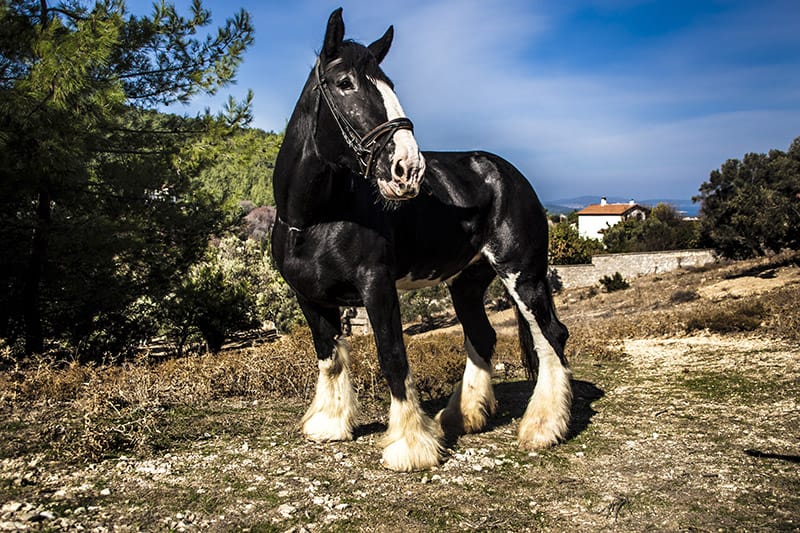The magnificent Shire is powerful and muscular, and is the tallest breed of horse!
A true “gentle giant”, the Shire is renowned for its docile temperament and strong work ethic. From battlefield to farmland, this noble horse has been a well mannered servant and faithful companion. The Shire’s great ancestors came from the “Old English Black Horse” of the central regions of England, counties commonly referred to as the “shires”.
Though its ancestry dates back to the Great Horses of the Medieval era, its use throughout history is one of aiding in the civilization of modern man. In the twelfth century, these heavy cob type horses were used as warhorses. Being strong and docile they were well suited to carrying the three hundred or so pounds of a fully armored knight into battle. Then farmers found their worth, being able to pull farm equipment and clear marshlands.
As the industrial age embarked, Shire horses were the original breed used to pull carts to deliver ale from the breweries. They have also been used in the United Kingdom as ceremonial drum horses in many royal processions. The Drum Horses lead the Household Calvary, ridden by drummers who work the reins with their feet while holding drumsticks in their hands.
Scientific Classification
| Kingdom: | Animalia |
| Phylum: | Chordata |
| Class: | Mammalia |
| Order: | Perissodactyla |
| Family: | Equidae |
| Genus: | Equus |
| Species: | caballus |
Horse Breeds
The Shire is a Draft Horse or Heavy horse. The Draft horse is also known as the Draught Horse or Dray Horse. ‘Dray’ is a word derived from the Anglo-Saxon term for ‘to haul’ or ‘to draw’.
The heavier draft horses were developed from the bulkier type of equines found in the northern hemisphere. These hardy horses evolved to survive in a colder harsher climate, and are much heavier and broader than the light horses. The breeds in this horse class are referred to as cold blood breeds, in reference to their quiet and calm temperament. They are heavy in the body, strong legged, and often have “feathers”, or long hair, covering their large hooves.

Horse Backgrounds
Robert Blackwell, a well known English livestock breeder began breeding shires in the mid 1700’s. The earliest recorded shire stallion was the Packington Blind Horse, born in 1755. This horse’s great ancestors came from the “Old English Black Horse” of the central regions of England, counties commonly referred to as the “shires”.
It is recorded that from 1199 to 1216, “one hundred stallions of large stature” were imported from Holland to breed with the stout cob type local mares of the midland counties of England. There, these heavy cob type horses were used by the knights in the twelfth century as warhorses. Their great strength and docile nature made them well suited to carry a fully armored knight weighing some three hundred pounds into battle.
Henry the eighth is credited with first applying the name “Shire” to these warhorses in the early 1500’s. He was determined to exploit the great worth of the Shire as a warhorse, and in 1535 passed a law prohibiting the breeding of any horse less than 15 hands high.
The invention of gunpowder in the sixteenth century changed the fate of the Shire. Smaller, quicker horses were needed in battle, and the number of these giant horses began to decline. Soon, however farmers discovered their worth as a farm animal and the numbers rebounded as they pulled farm equipment and helped clear marshland. The protective heavy hair on the Shires feet and legs were a useful adaptation to the farm work for which they were utilized.
With the industrial age the Shire became valued for its ability to pull heavy loads of goods from the docks and the breweries to the warehouses and shops in the city. In 1878 the English Cart Horse Society was formed and established a stud book in 1880. In 1884, the name Shire Horse Society was adapted. American export began in the mid 1800’s, and The American Shire Horse Association was established in 1885; the Canadian Shire Association in 1888.
Horse Care and Feeding
Shire horses are big eaters and should have plenty of fresh hay and clean water available. They have feathered ankles, making good grooming and sanitary conditions essential to avoid pododermititis, or “scratches” (a bacterial infection of the ankle).
The Shire horses are large and need adequate room to move around. If kept in stalls, be sure the stalls are large and well bedded enough to be comfortable for the horse.

Horse Training and Activities
This horse is noted for a quiet and calm temperament. Its great strength and docile nature makes horse training for this breed suitable in a variety of disciplines beyond just horse riding. well suited for many disciplines. The Shire has been successful in driving, jumping, dressage, and trail riding; all due to its tractable nature and trainability.
Common Health Problems
Although relatively rare, the Shire is one of the breeds more prone to a condition known as PSSM or Polysaccharide storage myopathy, commonly referred to as “shivers”. Symptoms of this condition, neurological in nature, include spasms in the hind limbs and difficulty in backing up. Often the symptoms can be managed with diet, but in extreme conditions the horse cannot raise its hind legs for hoof care and one or both the hind legs spasm when it begins moving. Extreme cases can be career ending, if not fatal.
Availability
Shire horses can be found on the internet. Many horses for sale ranging from approximately $2,500 to $20,000 USD depending on age, training, and bloodlines.
Featured Image Credit: Alla V, Shutterstock
